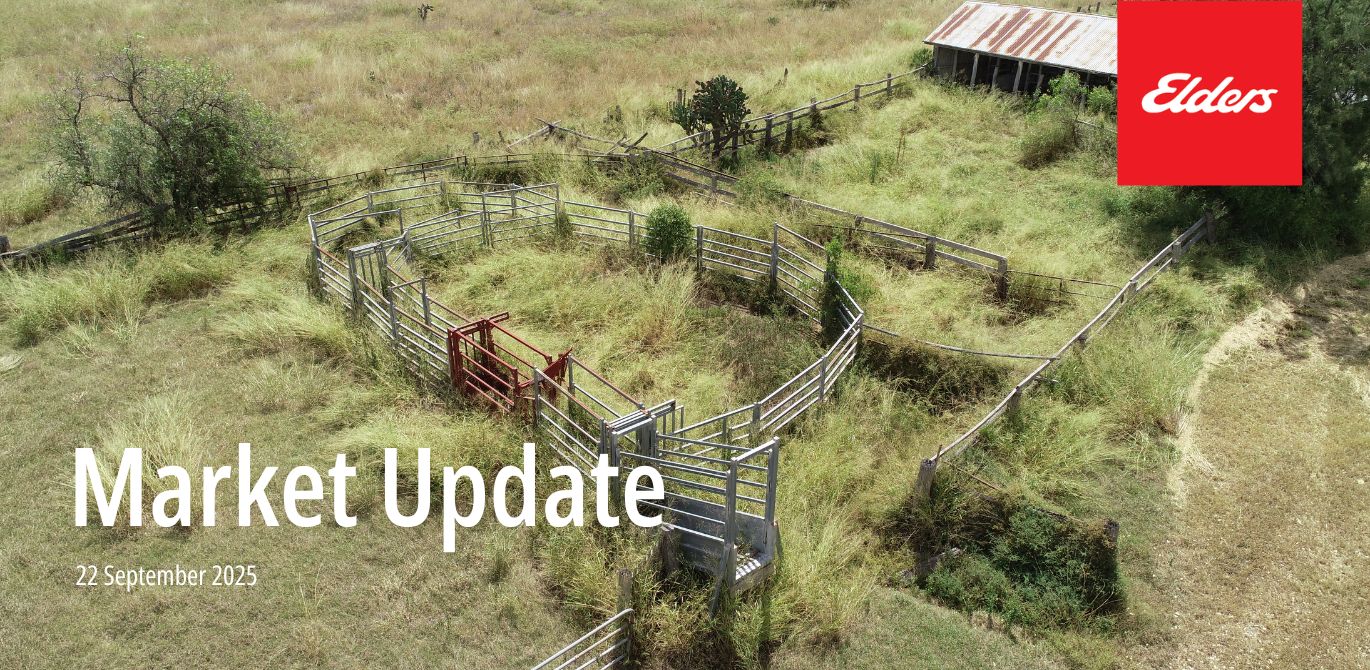Southern rainfall again missed many districts that need it most, cattle gained further support from rising US lean beef values, sheepmeat posted another powerful week on tight supply, global grain sentiment deteriorated as stocks swelled and subsidy talk grew louder, and wool extended its rally on stronger European and Chinese buying. Here is the wrap and what it means for producers in Queensland and the Northern Territory.
At a glance
- SA, Victoria and southern NSW largely missed useful rain. Key southern crops remain in the balance heading into spring heat.
- US lean beef prices rose again while Brazilian supply into the US contracted, improving Australian exporter leverage.
- Sheepmeat surged, with heavy and trade lambs near $12/kg cw and mutton pushing toward $8/kg cw.
- Global grains look ominous as stocks rise, policy support is canvassed in the US and EU, and oilseeds weaken on the US China impasse.
- Wool values lifted again with the EMI up 25c to 1344c/kg.
Weather
Northern NSW and southern Queensland received 15 to 25 mm, as did parts of WA’s inner wheatbelt, the lower south east of SA and Victoria’s western districts. Elsewhere on the east coast was disappointing. The Riverina and south west NSW, the SA and VIC Mallee, and the VIC Wimmera mostly saw 5 to 10 mm. Most WA cropping regions registered at least 5 to 10 mm. Bottom line, large areas of SA, Victoria and southern NSW remain finely balanced as temperatures rise.
Australian dollar
The A$ slipped back under 66 USc on US dollar strength after the Federal Reserve cut rates but guided to only gradual easing.
Livestock
Cattle
Slaughter cattle firmed again as US manufacturing beef prices rose. Australia’s bargaining position improved with less Brazilian competition. Brazilian beef shipments to the US are expected to fall to about 7,000 tonnes in September, down from 9,000 tonnes in August and well below the 30,000 tonnes per month seen before the new imposts. The US currently applies a 50 percent tariff on certain Brazilian goods alongside the 26.4 percent above quota beef tariff. Restocker interest softened in southern areas where the season tightened.
Sheepmeat
Another very strong week. Saleyard values pressed toward $12/kg cw for heavy and trade lambs, and remained above $11/kg cw for light, Merino and store lambs. The mutton indicator resumed climbing and is heading toward $8/kg cw as tight lamb supplies persist. If and when spring numbers lift, prices should cool, but there are no clear signs yet.
Grains
Old crop cash values eased by $5 to $10 per tonne across the week, barley under the most pressure. Indicative levels were Downs wheat $325/t and barley $295/t. Riverina feed markets were similar. South values were about $355/t for wheat into Melbourne, with barley at a $30/t discount, and similar pricing into Murray Bridge. New crop was generally $5 to $10/t under prompt, although track prices improved late on the weaker A$. The record US corn harvest is now underway. Warmth is hastening maturity and traders are watching early yield reports for signs that late dryness and crop disease may trim USDA estimates. Oilseeds remain heavy as China has not booked US soybeans at this point in the marketing year, an unusual position on the eve of harvest.
Policy risk is rising. US lawmakers are calling for additional farm support, including ideas to recycle tariff revenue to producers. With prices drifting toward or below cost of production in some origins and inputs still elevated, both the EU and US are openly canvassing more assistance. For Australia, that implies tougher competition in our traditional Asian demand centres, already contested by Black Sea and South American supply.
Wool
The dearer tone extended into this week’s sales. Finer Merino and crossbred categories led, with best specified lots that meet European requirements attracting notable premiums. Australia’s largest trader and exporter was a key buyer alongside Chinese indent and top making demand. The EMI gained 25c to 1344c/kg, a fresh year high.
Sugar
Raw sugar eased to a two and a half month low as Brazilian mills continued to favour crystal sugar over ethanol and Asian prospects, including India and Thailand, remained favourable.
US soybeans and the demand gap
On the eve of harvest, the US has not sold a single soybean cargo to China. Historically China takes 60 to 80 percent of US soybean export sales, around 20 million tonnes per year. While some volumes can be redirected, it is unlikely that non China demand can fully replace that gap. The risk is a build up of US stocks as harvest accelerates.
What it means for QLD and NT producers
Queensland and Northern Territory producers can expect slaughter categories to remain well supported while US lean beef strengthens and Brazilian volumes stay constrained, so keep close to paddock direct grids and processor space for heavy cows and steers. Restocker demand in the south may remain patchy until rain, which creates selective buying opportunities for backgrounders further north. Sheepmeat values are still attractive but vulnerable to an eventual lift in spring supply, so if finishing capacity is limited, consider locking in through forward or supply programs while grids are strong. Cheaper feed continues to improve economics for backgrounding and feedlot operations, while grain only businesses should use currency led rallies or short term logistics bumps to trim old crop and stay disciplined on forward sales until yield and quality risk in the south is clearer. In wool, the firmer tone is rewarding preparation, with well presented, European suited clips and certified lines drawing stronger competition.
You can rely on Elders for market timing, forward sales and seasonal strategy. Speak with your local Elders agent today.
